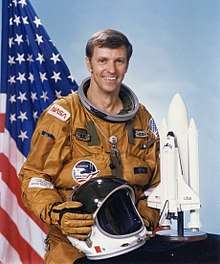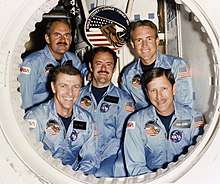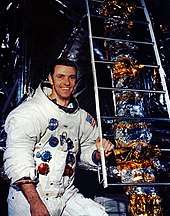Joe Engle
| Joe H. Engle | |
|---|---|
 | |
| USAF / NASA Astronaut | |
| Nationality | American |
| Status | Retired |
| Born |
August 26, 1932 Chapman, Kansas, U.S. |
Other names | Joe Henry Engle |
Other occupation | Test pilot |
| University of Kansas, B.S. 1955 | |
| Rank |
|
Time in space | 9d 08h 30m |
| Selection | 1966 NASA Group 5 |
| Missions | X-15 Flight 138, X-15 Flight 143, X-15 Flight 153, ALT, STS-2, STS-51-I |
Mission insignia |
|
| Retirement | November 28, 1986 |
| Awards |
|
Joe Henry Engle (born August 26, 1932) (Maj Gen, USAF, Ret.), is an American pilot who served in the United States Air Force, test pilot for the North American X-15 program, aeronautical engineer, and a former NASA astronaut. As of 2018, he is the last living pilot of the X-15 program.
Engle test-flew the joint NASA-Air Force X-15 rocket airplane. During the course of testing, Engle earned his USAF Astronaut Wings, a Distinguished Flying Cross and other awards. Engle was selected by NASA in 1966 for the Apollo program, and was originally scheduled to land on the Moon as Lunar Module Pilot on Apollo 17, but was bumped when later flights were cancelled, so that geologist-astronaut Harrison H. Schmitt could fly.
He subsequently became one of the first astronauts in the Space Shuttle program, having flight tested the Space Shuttle Enterprise in 1977. He was Commander of the second orbital test flight of the Space Shuttle Columbia in 1981.
Biography
Personal life and education
Engle was born on August 26, 1932, in Chapman, Kansas.[1] He attended primary and secondary schools in Chapman, Kansas, and he graduated from Dickinson County High School in 1950.[2] He received a Bachelor of Science degree in Aeronautical Engineering from the University of Kansas in 1955, where he was a member of the Theta Tau Professional Engineering Fraternity.[3][4]
Engle was active as a Boy Scout and earned the rank of First Class.[5]
He was married to Mary Catherine Lawrence of Mission Hills, Kansas and has two grown children and one stepchild. He is currently married to Jeanie Carter Engle of Houston, Texas. Engle's recreational interests include flying (including World War II fighter aircraft), big game hunting, backpacking, and athletics.[4]
He was a member of the Society of Experimental Test Pilots and became a Fellow in 2009.[6]
Flight experience

Engle received his commission in the U.S. Air Force through the Air Force Reserve Officer Training Corps at the University of Kansas. While in school he was a member of the Professional Engineering Fraternity Theta Tau, and decided to become a test pilot. While working at Cessna Aircraft during the summer, he learned how to fly from a fellow draftsman.[7]
Engle entered flying school in 1957, and received his pilot wings in 1958. He flew the F-100 Super Sabre with the 474th Fighter Day Squadron and the 309th Tactical Fighter Squadron at George Air Force Base, California. Chuck Yeager recommended Engle for USAF Test Pilot School, from which he graduated in 1961, and he was later assigned to the second class of the Aerospace Research Pilot School, despite his reluctance to leave "stick and rudder" flying for a space capsule.[7]
After serving as a test pilot in the Fighter Test Group at Edwards Air Force Base, California, Engle was a test pilot in the X-15 research program at Edwards from June 1963 until his assignment to the Manned Spacecraft Center (now the Lyndon B. Johnson Space Center). Engle had applied with fellow ARPS student Michael Collins to the third NASA astronaut group, but the Air Force withdrew Engle's NASA application and instead chose him to replace Robert M. White in the X-15 program, which pleased Engle.[7]
Engle's parents witnessed his flight of 29 June 1965, which exceeded an altitude of 50 miles (80 km) and qualified him for astronaut wings; he again exceeded 50 miles twice[7] during his career of 16 flights. On his final X-15 mission, free flight 153 (1-61-101), which took place on 14th October 1965, he became the first of only two pilots to accomplish a sub-orbital space flight in an X-15 without the benefit of the assistance provided by the MH-96 adaptive flight control system[8]. Despite what he later called "the best flying job in the world", Engle decided to apply again to NASA as he expected to be rotated to another Air Force assignment within a year and hoped to go to the Moon.[7]
Engle has flown over 185 different types of aircraft (25 different fighters) during his career: logging more than 15,400 hours flight time; 9,000 in jet aircraft.[1]
NASA career

Engle was one of 19 astronauts selected by NASA in April 1966. He served on the support crew for Apollo 10. Following this assignment, he was backup Lunar Module Pilot for the Apollo 14 mission and was due to land on the Moon as Lunar Module Pilot for Apollo 17, but was replaced by geologist Harrison Schmitt after Apollo 18 was cancelled with pressure from the scientific community to have a scientist explore the Moon, and not just test pilots who had been given geology training. In response to getting bumped from the mission, he said "When you think about it, the lunar missions were geology-oriented."[4]
According to Engle, Deke Slayton asked him whether he would prefer to fly on Skylab, Apollo-Soyuz, or the Space Shuttle; Engle responded that he would prefer the Shuttle as it was an airplane.[7]

Engle was Commander of one of the two crews that flew the Space Shuttle Approach and Landing Test Flights from June through October 1977. The Space Shuttle Enterprise was carried to 25,000 feet on top of the Boeing 747 carrier aircraft, and then released for its two-minute glide flight to landing. In this series of flight tests, Engle evaluated the Orbiter handling qualities and landing characteristics, and obtained the stability and control, and performance data in the subsonic flight envelope for the space shuttle. He was the backup Commander for STS-1, the first orbital test flight of Space Shuttle Columbia. Together with pilot Richard Truly he flew as Commander on the second flight of the Space Shuttle, STS-2. He was also mission commander on STS-51-I and logged over 225 hours in space.[7]
Engle is the only human being to have flown two different types of winged vehicles in space, the X-15 and the Space Shuttle. In Engle's June 2004 oral history interview the interviewer (Rebecca Wright) states that he is the only astronaut to have manually flown the Shuttle through reentry and landing, [7] but this is an oversimplification. Periods of hand flying flight test manoeuvres were interspersed with periods of computer control. [9]
He served as Deputy Associate Administrator for Manned Space Flight at NASA Headquarters from March 1982 to December 1982.[1] He retained his astronaut flight status and returned to the Johnson Space Center in January 1983.[1] He also participated in the Challenger disaster investigation in 1986, and did other consulting work on the Shuttle well into the 1990s.[10]
Post-NASA career
Joe Engle retired from NASA on November 28, 1986[11] and the USAF on November 30, 1986. On December 1, he was subsequently promoted to the rank of Major General. In 1986 he was appointed to the Kansas Air National Guard and 1992, he was inducted into the Aerospace Walk of Honor. On July 21, 2001, Engle was enshrined at Dayton, Ohio, in the National Aviation Hall of Fame class of 2001, along with USAF ace Robin Olds, U.S. Marine Corps ace Marion Carl, and Albert Ueltschi. In November, 2001, he was inducted into the U.S. Astronaut Hall of Fame in Florida.[12]
Awards and honors

- USAF Astronaut Badge (1964)[13]
- Defense Distinguished Service Medal - "for outstanding achievements"[1]
- Air Force Distinguished Service Medal (1985)[1][14]
- Distinguished Flying Cross, twice (1964 and 1978) - "for outstanding achievements"[4][14]
- NASA Distinguished Service Medal[1][14]
- Two NASA Space Flight Medals[15]
- NASA Exceptional Service Medal[1][14]
- NASA Special Achievement Award[15]
- American Institute of Aeronautics and Astronautics (AIAA) Pioneer of Flight Award 1965[15]
- AIAA Lawrence Sperry Award for Flight Research 1966[16]
- Iven C. Kincheloe Prize awarded by the Society of Experimental Test Pilots (1977) - for taking part in testing the Space Shuttle Enterprise[14]
- AIAA Haley Space Flight Award (1980)[17]
- Dr. Robert H. Goddard Memorial Trophy[14]
- Robert J. Collier Trophy[1][14]
- Harmon International Trophy[1]
- University of Kansas Distinguished Service Citation (1982)[18]
- General Thomas D. White USAF Space Trophy[1]
- Aerospace Walk of Honor, Lancaster, California (1992)[19]
- National Aviation Hall of Fame, Dayton (Ohio)[14]
- U.S. Astronaut Hall of Fame, Florida (2001).[12]
- Award of Air Force Space and Missile Pioneers (2007)[20]
- International Air & Space Hall of Fame (2014)[21]
References
- 1 2 3 4 5 6 7 8 9 10 11 "Astronaut Bio: Joe Henry Engle". NASA JSC. Retrieved December 5, 2016.
- ↑ "Dickinson County's historical high school". The Salina Journal. September 10, 1989. p. 33. Retrieved December 1, 2017 – via Newspapers.com.
- ↑ "Alumni Hall of Fame Laureates" (PDF). Theta Tau. Retrieved December 1, 2017.
- 1 2 3 4 "ENGLE: FROM CHILDHOOD HE PLANNED TO BE A PILOT". New York Times. November 13, 1981. Retrieved December 1, 2017.
- ↑ Joe H. Engle at scouting.org Archived 2016-03-04 at the Wayback Machine.
- ↑ "Fellow Classes". The Society of Experimental Test Pilots. Retrieved December 1, 2017.
- 1 2 3 4 5 6 7 8 "Joe H. Engle", NASA Johnson Space Center Oral History Project, 22 April to 24 June 2004.
- ↑ "The X-15 Rocket Plane, Flight Log, Page 44" (PDF). Michelle Evans. 2013.
- ↑ Dennis R. Jenkins (2017). Space Shuttle: Developing an Icon 1972-2013. Speciality Press. ISBN 9781580072496.
- ↑ "Engle, Joe Henry". The National Aviation Hall of Fame. Retrieved December 1, 2017.
- ↑ Recer, Paul (2 December 1986). "Senior NASA astronaut Joe H. Engle retires". AP. Retrieved 17 July 2013.
- 1 2 "Joe Engle inducted into the U.S. Astronaut Hall of Fame". Astronaut Scholarship Foundation.
- ↑ Pearlman, Robert (August 23, 2005). "Former NASA X-15 Pilots Awarded Astronaut Wings". Space.com. Retrieved December 1, 2017.
- 1 2 3 4 5 6 7 8 Shayler, David; Burgess, Colin. The Last of NASA's Original Pilot Astronauts: Expanding the Space Frontier in the Late Sixties. Springer. p. 372. ISBN 9783319510149.
- 1 2 3 "NASA JOHNSON SPACE CENTER ORAL HISTORY PROJECT: BIOGRAPHICAL DATA Sheet" (PDF). NASA JSC. Retrieved December 1, 2017.
- ↑ "Lawrence Sperry Award Recipients". AIAA. Retrieved December 1, 2017.
- ↑ "Haley Space Flight Award Recipients". AIAA. Retrieved December 1, 2017.
- ↑ "Astronauts Joe Engle, Steven Hawley to serve as grand marshals for Homecoming parade". University of Kansas. September 8, 2017. Retrieved December 1, 2017.
- ↑ "Walk of Honor". City of Lancaster. Retrieved December 1, 2017.
- ↑ Rust, Kate (July 6, 2007). "Two Space & Missile Pioneers selected for 2007". USAF. Retrieved December 2, 2017.
- ↑ Sprekelmeyer, Linda, editor. These We Honor: The International Aerospace Hall of Fame. Donning Co. Publishers, 2006. ISBN 978-1-57864-397-4.
Bibliography
- Thompson, Milton O. (1992) At The Edge Of Space: The X-15 Flight Program, Smithsonian Institution Press, Washington and London. ISBN 1-56098-107-5
External links
| Wikimedia Commons has media related to Joe Engle. |